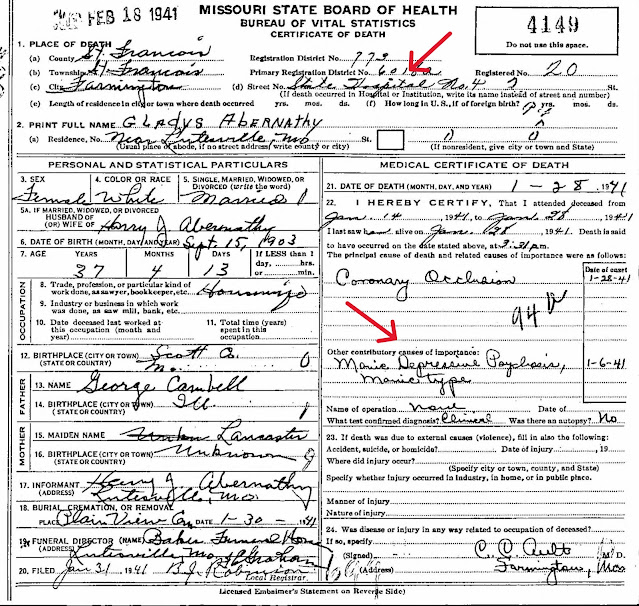Edward W. Abernathy was born on 15 May 1887 in Appleton, Missouri, a village located along the south bank of Apple Creek, the boundary line between Cape Girardeau and Perry counties. Appleton Bridge, originally built in 1879, connects the two counties.
A source for E.W.'s birthplace is his World War I draft registration. Edward's parents, Henderson William Abernathy and Rachel M. Hemrich, were residing in Apple Creek Township, Cape Girardeau County, Missouri seven years before his birth. A June 1900 U.S. Federal census record places the teenaged Edward in Salem Township, Perry County, Missouri.
On 26 January 1909 in Perry County, Edward Abernathy married Mary L. Cox, one of the more than ten children born to Elizabeth Cotner and Rev. William Marion Cox. The younger couple would go on to have at least eight children of their own.
Though we can be sure this Abernathy family experienced times of joy and sorrow in every decade, the 1930s proved to be especially challenging. While persevering through the throes of the Great Depression, the infectious disease of tuberculosis would exact its terrible toll on the family three times over seven years.
First, there was son Ivan E. He was born on 16 January 1916 at Crosstown, Perry County, Missouri. He quite possibly began battling the disease in early 1931 at the age of fifteen. According to Ivan's death certificate, influenza was a contributing factor to his demise. This piling on of a second infectious disease proved to be too much, and Ivan died of Tuberculosis of Lungs on the morning of 3 April 1932.
Next, it came for the patriarch. About the time the Works Progress Administration was being created, the Rural Electrification Act was being implemented, and the United States was battling a near country-wide heat wave, Edward Abernathy was diagnosed with Pulmonary Tuberculosis. By April 1937, the prognosis was grim with the additions of Tuberculous Meningitis, Enteritis, Emphysema, and Pericarditis. He was gone less than two months later, with Pulmonary Tuberculosis still being the official cause of death not long before midnight on 6 June 1937. Edward breathed his last breath at the Mt. St. Rose Sanitorium in St. Louis, Missouri.
And then there was daughter Alma Rachel. She was born on 14 June 1918 in Perry County, Missouri. On 8 October 1938, the twenty-year-old married Edgar J. Rubel. Six months later, Alma was dead. She died of T.B. of Lungs on 11 April 1939. Her death certificate implied she'd had the disease for months, at minimum.
According to "The Forgotten Plague," an American Experience documentary, "As the scientific knowledge of tuberculosis progressed, so too did the prejudice toward people with the disease. Once it was learned that TB was not in fact hereditary, but was transmitted through person-to-person contact, those who suffered from the disease were ostracized from society." Even apart from the obvious sorrow, it's likely all members of the Edward W. Abernathy family were burdened by their connection to tuberculosis.
Note: all documents highlighted above and used to tell part of the story of the Edward W. Abernathy family were found with an Ancestry membership. Interested in learning more about your family history? Try a 14-day free trial today with Ancestry® (affiliate link).





















